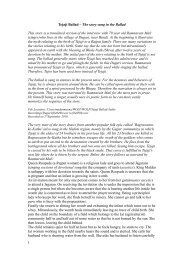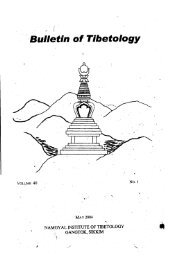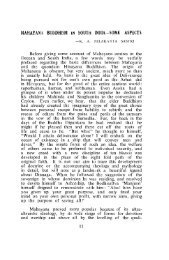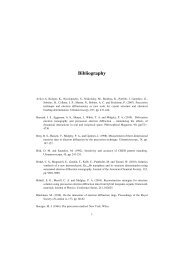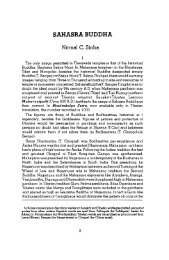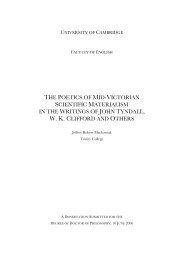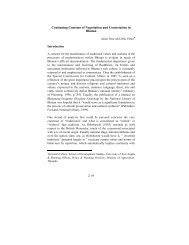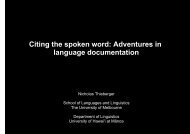The Crusades, the Genoese and the Latin East - DSpace at ...
The Crusades, the Genoese and the Latin East - DSpace at ...
The Crusades, the Genoese and the Latin East - DSpace at ...
You also want an ePaper? Increase the reach of your titles
YUMPU automatically turns print PDFs into web optimized ePapers that Google loves.
notary Lanfranco from <strong>the</strong> first eight months of 1203 were of a domestic n<strong>at</strong>ure. <strong>The</strong>y concern<br />
properties, mobile <strong>and</strong> immobile goods, wills as well as marriage agreements. By contrast, <strong>the</strong><br />
cartulary of Giovanni di Guiberto from <strong>the</strong> same year contains 508 records out of which 302 are<br />
travelling contracts. Significantly, all <strong>the</strong> documents in this cartulary were written in a span of<br />
two <strong>and</strong> a half months from 19 September 1203, during <strong>the</strong> autumn sailing period. When <strong>the</strong> trade<br />
routes <strong>and</strong> <strong>the</strong> travel history of <strong>Genoese</strong> ships are being examined, it is important to bear in mind<br />
th<strong>at</strong> <strong>the</strong> contracts present <strong>the</strong> sailing plans only before setting off from Genoa. <strong>The</strong> way <strong>the</strong> routes<br />
changed l<strong>at</strong>er on in <strong>the</strong> journey is not known. Shelomo Goitein, for example, argued th<strong>at</strong> `it was<br />
common for <strong>the</strong> people represented in <strong>the</strong> Geniza records to travel on <strong>Genoese</strong>, Pisan or Gaetan<br />
ships, as well as vessels of o<strong>the</strong>r western powers. '4 In <strong>the</strong> records of Genoa, however, <strong>the</strong> story is<br />
one-sided.<br />
Unlike letters of concessions, charters <strong>and</strong> o<strong>the</strong>r diplom<strong>at</strong>ic documents, a single notarial<br />
record only rarely tells a complete story. Even when inform<strong>at</strong>ion is ga<strong>the</strong>red from several notarial<br />
records <strong>the</strong>y generally reveal just sc<strong>at</strong>tered parts of <strong>the</strong> sequence of events. Remie Constable<br />
noted how `notarial m<strong>at</strong>erials are more suited to showing <strong>the</strong> results of change than change<br />
itself. '5 This observ<strong>at</strong>ion holds an important lesson for whoever wishes to use notarial documents<br />
in research. P<strong>at</strong>terns must be identified first, before one can recognise any change th<strong>at</strong> may have<br />
occurred. <strong>The</strong> time factor is important too. From <strong>the</strong> instant major political or military changes<br />
occurred, it took some time until <strong>the</strong> change could become noticeable in notarial acts. For<br />
example, it will be argued th<strong>at</strong> <strong>the</strong> earliest written permission given to merchants by <strong>the</strong>ir residing<br />
partners to travel to Aleppo was granted in September 1203. <strong>The</strong> diplom<strong>at</strong>ic negoti<strong>at</strong>ions th<strong>at</strong><br />
made this route available, however, must have taken place beforeh<strong>and</strong>. Moreover, none of <strong>the</strong><br />
contracts explains when this travel route was opened or why merchants wanted to travel to<br />
Aleppo to begin with. In Chapter Two, <strong>the</strong>se permissions will be examined in <strong>the</strong> context of <strong>the</strong><br />
changes in <strong>the</strong> Mediterranean's web of commerce during <strong>the</strong> course of <strong>the</strong> Fourth Crusade. It will<br />
be argued th<strong>at</strong> <strong>the</strong>re is some correl<strong>at</strong>ion between <strong>the</strong>se events. <strong>The</strong> opening of <strong>the</strong> route to Aleppo<br />
will be discussed in <strong>the</strong> context of <strong>the</strong> rel<strong>at</strong>ionship between Genoa <strong>and</strong> Byblos, a city on <strong>the</strong> route<br />
between <strong>the</strong> ports of <strong>the</strong> kingdom of Jerusalem <strong>and</strong> Aleppo. Importantly, Byblos was originally<br />
granted to <strong>the</strong> ca<strong>the</strong>dral church of St Lawrence <strong>and</strong> <strong>the</strong> commune of Genoa <strong>and</strong> was ruled by<br />
descendents of <strong>the</strong> noble <strong>Genoese</strong> family Embriaco. This family connection <strong>and</strong> <strong>the</strong> history of <strong>the</strong><br />
a Shelomo D. Goitein, A Mediterranean Society: An Abridgment in One Volume, ed. Jacob Lassner,<br />
(Berkeley, 1999), pp. 36-7.<br />
Olivia R. Constable, `Genoa <strong>and</strong> Spain in <strong>the</strong> Twelfth <strong>and</strong> Thirteenth Centuries: Notarial Evidence for a<br />
Shift in P<strong>at</strong>terns of Trade', Journal of European Economic History, 19: 3 (1990), p. 637.<br />
12



